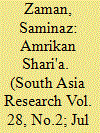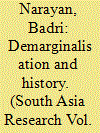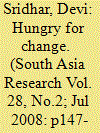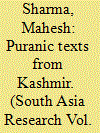|
|
|
Sort Order |
|
|
|
Items / Page
|
|
|
|
|
|
|
| Srl | Item |
| 1 |
ID:
082558


|
|
|
|
|
| Publication |
2008.
|
| Summary/Abstract |
This article examines the growth and development of the hybridized practice of Muslim laws in the shadow of the American legal system, a form of unofficial law that may be called amrikan shari'a. Following the immigration trajectory of many American Muslims, transnational information links forged by wide-scale immigration are explored, particularly the innovative use of new online resources available to Muslim immigrants in America and the proliferation of online fiqh discussion groups, which has fostered the very American character of the do-it-yourself mufti. A further section considers several mahr cases that have reached American courtrooms and compares one such case with a similar English case, which was decided rather differently. The article concludes with an assessment of how the Bush government's 'War on Terror' and domestic US developments, such as legalizing gay marriage in Massachusetts and the increasing presence of second-generation Muslim Americans, combine to affect the future of amrikan shari'a within a secular legal system
|
|
|
|
|
|
|
|
|
|
|
|
|
|
|
|
| 2 |
ID:
082557


|
|
|
|
|
| Publication |
2008.
|
| Summary/Abstract |
The article demonstrates how the ongoing demarginalisation of Dalits in India today works on a variety of levels. Through creating new narratives and virtually inventing a new alternative history and language, this movement for demarginalisation uses a particular style of popular and widely circulated booklets, vigorously read and disseminated by the neo-literate Dalit population. The construction of this alternative history through such new texts, seen as an existential necessity for the Dalits, works by weaving together stories found in religious Brahminical popular texts about dissenting lower caste characters, glorified as Dalit heroes who fought against upper caste oppression and injustice. It also includes stories of unsung Dalit freedom fighters, transformed into local myths. Importantly, the language used is different from Standard Hindi, since folk proverbs, idioms and symbols, as well as the grammar and vocabulary of local dialects, are used. The article demonstrates in some detail how these processes of constructing new literature work, and indicates that these new sources may well be laying foundations for the histories of the future of many subaltern communities of South Asia
|
|
|
|
|
|
|
|
|
|
|
|
|
|
|
|
| 3 |
ID:
082556


|
|
|
|
|
| Publication |
2008.
|
| Summary/Abstract |
The World Bank has become the largest financial contributor to health-related and nutrition projects, committing more than $1 billion annually towards the health, nutrition and population sector. This article examines how the World Bank addressed malnutrition in Tamil Nadu and discusses the consequences of this approach for the Bank's projects and target communities. Using the case study of the Tamil Nadu Integrated Nutrition Project (TINP), it is argued that the World Bank nutrition package, now implemented in several countries, might not be effective in extremely poor and destitute communities because it does not address the underlying social causes of malnutrition. The final section of the article goes 'inside' the Bank to examine two institutional drivers that could explain the promotion of the TINP approach to undernutrition
|
|
|
|
|
|
|
|
|
|
|
|
|
|
|
|
| 4 |
ID:
082551


|
|
|
|
|
| Publication |
2008.
|
| Summary/Abstract |
Focusing on the western Himalayan provinces of Kashmir and Himachal Pradesh, this article argues that the Indian hagiographic texts of the Puranas should be understood as a nuanced literature that sought to effect a paradigm shift in liturgy and praxis, fusing polity and religion, largely in contravention to the earlier Vedic-Upanishadic texts and their commentaries, but also building on them. Emphasis on local Sanskrit literature, specifically the Nilamata Purana, which uses popular iconographies of river goddesses, served many centuries ago to reconstruct the geography of the area within the wider context of the subcontinental sacred geography.
Keeping within the Puranic tradition, the article focuses on the rituals and ceremonials associated with rivers, while also charting the process by which regional pilgrim centres were formed on their banks, devising a sacred space parallel to the subcontinental cosmos. This reinforces the logic of the sacred river, the worshipped deity, as a process by which brahmanic dominance was asserted in the peripheral areas of early India, or ideologically and politically contested regions such as Kashmir. In the sacrality of the river Vitasta, Brahmanism as an ideology reasserts itself by restating the tradition in relation to its sacral past, creating a new sacred space and devising a sacred icon to reclaim this particular geography for the devout Brahmanas
|
|
|
|
|
|
|
|
|
|
|
|
|
|
|
|
| 5 |
ID:
082559


|
|
|
|
|
| Publication |
2008.
|
| Summary/Abstract |
This article examines the employment and occupational status of South Asian female migrants in Australia, mostly Indian and Sri Lankan. It highlights their work differentials with both native-born and other female migrants in this multicultural context and confirms that they are a highly selected population who potentially bring considerable economic benefits to the receiving society. The observation that South Asian female migrants in Australia are able to contribute significant human capital in the form of language and education skills, but do so to some extent on their own terms, suggests that more careful attention needs to be paid to selecting migrants from South Asia and facilitating their entry into the labour market
|
|
|
|
|
|
|
|
|
|
|
|
|
|
|
|
|
|
|
|
|